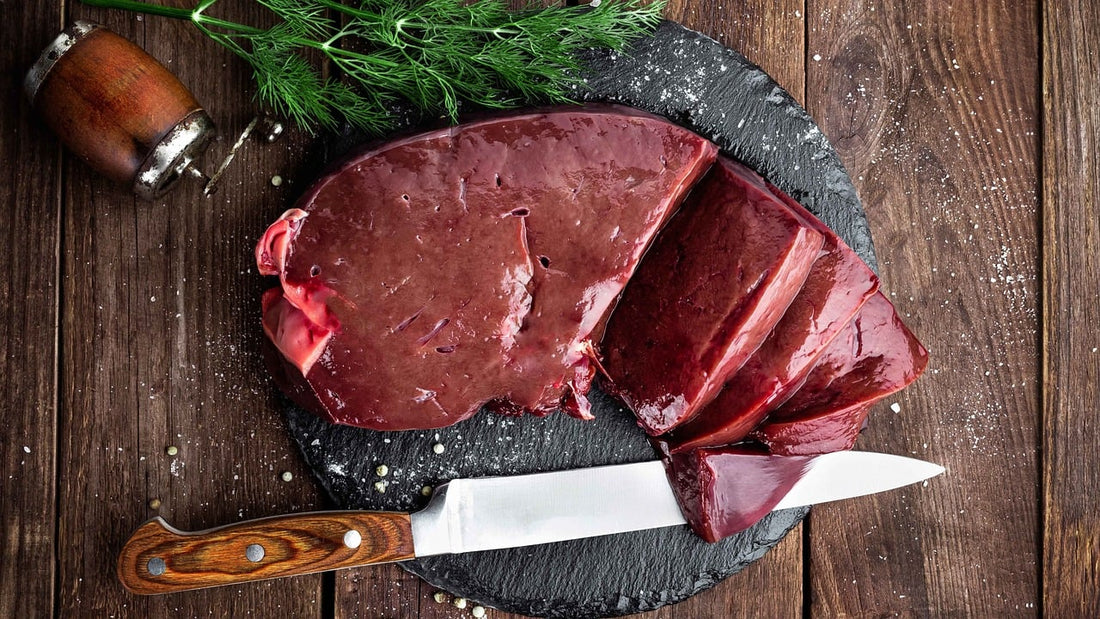
Why Organ Meats Are a Superfood for Dogs and Cats (with DIY Recipes!)
Annmarie Palazzola-HolbrookShare
Did you Say Organ Meat is a Superfood for Dogs and Cats?
Yes. And, you're welcome!
Organ meats are among the most powerful, natural, and nutrient-packed superfoods. These often overlooked meats are packed with essential vitamins, minerals, and proteins to take your pet’s diet to the next level.

4theluvofdog is a participant in the Amazon Services LLC Associates Program, an affiliate advertising program designed to provide a means for sites to earn advertising fees by advertising and linking to amazon.com Please read my full disclosure.
"Let’s explore why organ meats are considered a superfood for your pets! We’ll also check out a few easy DIY recipes to incorporate at treat time for your dogs and cats—recipes they’ll absolutely love!"

(Image Credits: Annmarie Holbrook) Dehydrated Liver & Carob Sandwich
Organ meats also make a great food topper during mealtime. "I top my dog's food with either freeze dried liver or freeze dried beef lung. They seem to gobble up both. Win-Win!
What Are Organ Meats? 
When you hear the term organ meats, what comes to mind? Many people think of offal, which includes internal animal organs such as the liver, kidney, heart, and gizzards.
These animal parts may not sound glamorous, but they are often overlooked in pet diets despite their powerful nutritional benefits. Organ meats are packed with bioavailable nutrients, vitamins, and minerals that your pet’s body can easily absorb.
Types of Organ Meats for Dogs & Cats
There are many types of organ meats that dogs and cats can consume. Some of the most popular include:
- Liver – High in Vitamin A, B vitamins (especially B12), iron, folic acid, and copper. Supports vision, immune function, and red blood cell production.
- Heart – A great source of CoQ10, taurine, and protein. Essential for heart and muscle health.
- Lung – A lean source of protein with minimal fat content.
- Kidney – Packed with B12, selenium, and essential minerals for overall well-being.
- Spleen – Rich in iron and Vitamin B12, which help support immune function and blood health.
- Brain – Loaded with Omega-3 fatty acids, supporting cognitive health and nervous system function.
The Nutritional Benefits of Organ Meats
Organ meats are considered a superfood for pets (and humans too—but let’s focus on pets for now!).
Key Nutritional Benefits:
Rich in Vitamins & Minerals – Packed with Vitamin A, B vitamins, iron, copper, and zinc.
High-Quality Protein – Provides essential amino acids that aid in muscle repair and growth.
Supports Vital Organs – CoQ10 and taurine in heart meat promote cardiovascular health, while glucosamine in gizzards supports joint function.
Boosts Energy & Immunity – Enhances energy levels and strengthens the immune system.
Improves Skin & Coat – Omega fatty acids and biotin contribute to a shiny, healthy coat.

🐾 Fun Fact!
Did you know? Gizzards are a tough, lean muscle that can naturally clean your pet's teeth while they chew—acting as a built-in dental treat!
Raw vs. Freeze-Dried vs. Cooked Organ Meats: Benefits & Risks
1. Raw Organ Meats
Pros:
- Maximum nutrient retention, preserving enzymes, amino acids, and vitamins.
- Supports a biologically appropriate raw diet (BARF).
- Ideal for pets with allergies to processed foods.
Cons:
- Potential bacterial contamination (Salmonella, E. coli).
- Must be sourced from high-quality, trusted suppliers.
- Can cause digestive upset if introduced too quickly. Start slow!
2. Freeze-Dried Organ Meats
Pros:
- Retains most nutrients while being shelf-stable and convenient.
- Less risk of bacterial contamination than raw.
- Great for training treats or meal toppers.
Cons:
- Some pets may need rehydration for easier digestion (try warm water or bone broth).
3. Cooked Organ Meats
Pros:
- Cooking eliminates bacteria and parasites.
- Easier to digest for pets with sensitive stomachs.
- Still provides essential nutrients like iron and protein.
Cons:
- Heat-sensitive vitamins (B vitamins, taurine) are reduced.
- Overcooking can make organ meats tough and less palatable.
How to Safely Introduce Organ Meats Into Your Pet’s Diet
Although organ meats are highly nutritious, it's important to introduce them gradually. Here are some tips:
Start Small – Offer 5-10% of your pet’s total diet as organ meat.
Choose High-Quality Sources – Opt for human-grade organ meats from trusted suppliers.
Consult Your Vet – Especially if your pet has specific health concerns.
Best Organ Meats for Cats
🐾 Liver – High in Vitamin A, but should be fed in moderation (excess can cause toxicity).
🐾 Heart – A natural source of taurine, essential for heart and eye health.
🐾 Kidney & Spleen – Packed with B vitamins, iron, and zinc for overall vitality.
Example: Organ Meat in a Cat’s Diet (5-10%)
🐈 A 10 lb cat eating ½ cup of food per day:
- 5% Organ Meat = 1 teaspoon
- 10% Organ Meat = 2 teaspoons
Tips for Introducing Organ Meats to Cats
🐾 Start slow – Mix a tiny amount into their regular food.
🐾 Serve raw or lightly cooked – Never season organ meats.
🐾 Try freeze-dried if your cat refuses raw.
🐾 If stools are too soft, reduce the portion and increase gradually.
Best Organ Meats for Dogs
- Liver – Vitamin A, B vitamins, and iron. ⚠️ Limit to 5% of diet to avoid toxicity.
- Heart – High in taurine and CoQ10, supports heart health.
- Kidney – Rich in B vitamins, selenium, and Omega-3s.
- Spleen – Packed with iron and B12 for blood health.
- Brain – Loaded with Omega-3s for cognitive function.
- Lung – High in protein and elastin for joint support.
- Pancreas – Supports digestion with natural enzymes.
Example: Organ Meat in a Dog’s Diet (5-10%)
🐶 A dog eating 1 cup of food per day:
- 5% Organ Meat = ½ tablespoon
- 10% Organ Meat = 1 tablespoon
Always adjust based on your pet’s weight, breed, and age.
"Looking for an easy way to add organ meats to your pet's diet? Seriously, the added nutrition was a game-changer for my fur babies. I use freeze-dried beef liver bites by Nutri bites, for my dogs and cats. I place a few as food toppers.
Just read the instructions on servings. Two out of my 3 cats loved the dehydrated liver bites. They don't need as much. Win-win!

🐾 Fun Fact!
Did you know? Wild carnivores instinctively eat organ meats first because they contain the most nutrients!
DIY Recipes: Add Organ Meats to Your Pet’s Diet
🐶 Beef Liver & Veggie Bowl for Dogs
Ingredients:
✔️ 1 cup beef liver (cubed)
✔️ 1 cup sweet potatoes (boiled & mashed)
✔️ ½ cup green beans (steamed)
✔️ 1 tbsp coconut oil
Instructions:
- Heat coconut oil in a pan and sauté beef liver for 5 minutes.
- In a bowl, combine cooked liver, mashed sweet potatoes, and green beans.
- Serve as a meal topper or mix with kibble.
🐕 Nutritional Benefits: High in Vitamin A & fiber, supports digestion & immunity.
🐱 Chicken Heart Purée for Cats
Ingredients:
✔️ 1 cup chicken hearts
✔️ ½ cup chicken broth (low sodium)
✔️ 1 tsp fish oil
Instructions:
- Boil chicken hearts for 10 minutes.
- Blend with chicken broth & fish oil until smooth.
- Serve as a meal topper or freeze for later. - Try our easy to fill fun-shaped silicone molds
🐈 Nutritional Benefits: Rich in taurine, supports heart & vision health.
Bonus Quick Dog Treat Recipe

(Image Credits: Annmarie Holbrook) Dehydrated Liver and Carob Sandwich Dog Treat
Dehydrated Beef Liver & Carob sandwich
Ingredients
How to put it all together!
Instructions
Place one wafer on a plate. stack with 2-3 dehydrated liver bites. You will want to reheat your already made carob bites in the microwave at 20 second intervals until it melts completely.
Once melted, poor it over the dehydrated liver bites. Place the second wafer on top and serve to your dog.
This works wonders in the afternoon when my dogs get a little anxious and bored. ;D
These Are My MUST-HAVE Products for Feeding Organ Meats
- Best Freeze-dried Liver Meats - Nutri Bites freeze-dried beef liver for Dogs and Cats treats
- Best Freeze-dried Lamb Lung Organ Meats - Riley's Premium dehydrated Lamb Lung treats or food toppers.
- Gamma makes some of the BEST food storage containers. My 25 lb. bag fits just fine! I don't have to worry about ants or mice getting into my dog's food. - Gamma2 Vault Pet food container made in the USA.
- Cat food storage container - BPA-free and easy to use for travel. LOVE THIS!
- Bone Broth Powder -Native Pet Bone Broth Powder for Dogs and Cats
- Fish Oil - Wild Alaskan Salmon Oil Formula for Dogs & Cats
Was this guide helpful? What organ meats have you given to your dog or cat? Let me know in the comments.
I would love to hear from you! -Annmarie
The Legal Section
All content on this website, including text, images, and original recipes, is the intellectual property of 4theluvofDog.com unless otherwise stated. Unauthorized use, reproduction, or distribution of any content from this site without written permission is strictly prohibited and may result in legal action under the Digital Millennium Copyright Act (DMCA) and applicable copyright laws.
If you would like to share a post, please link directly to the original content and provide proper credit. Copying and pasting full content is not allowed.
© 4theluvofDog.com | All Rights Reserved

